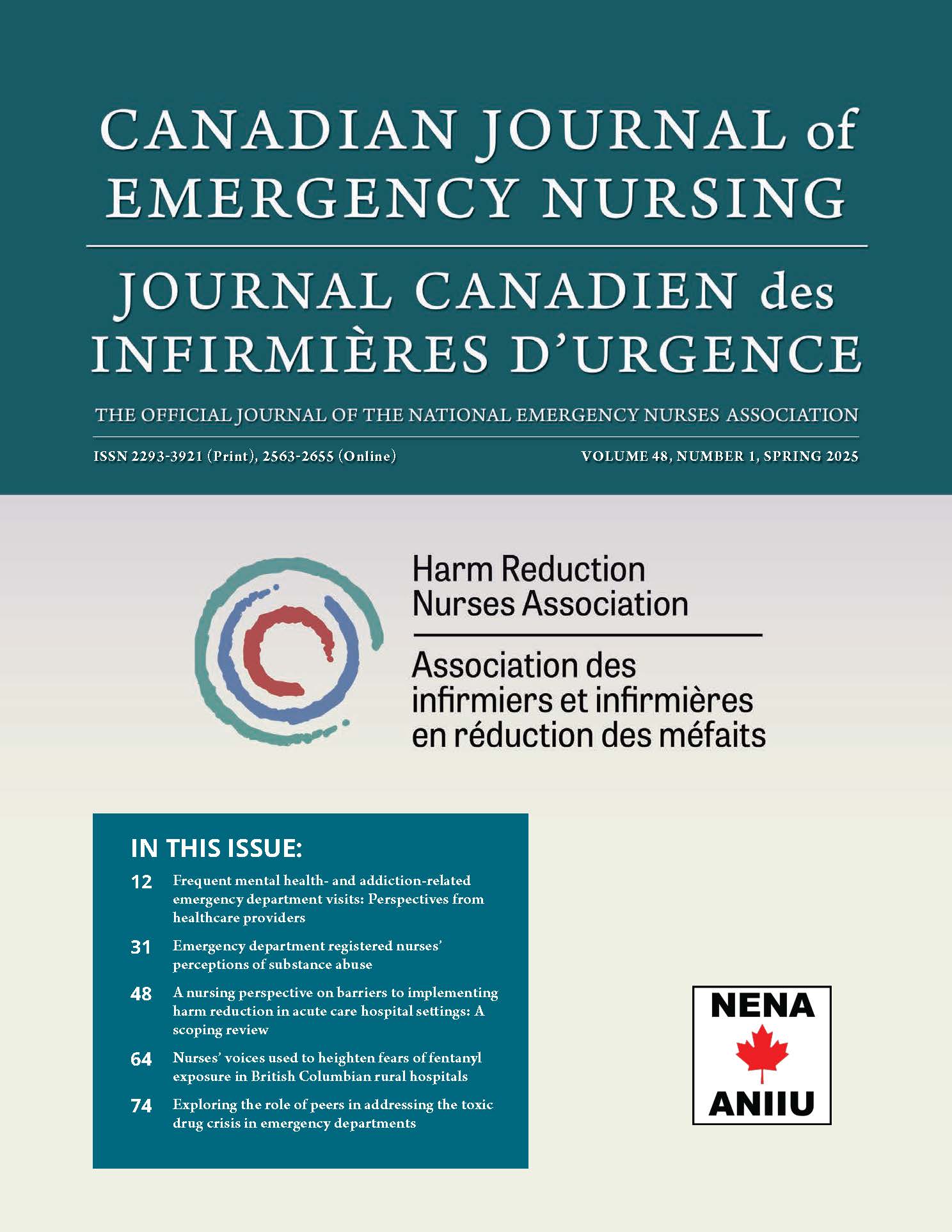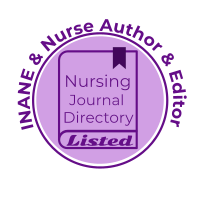Exploring the role of peers in addressing the toxic drug crisis in emergency departments
DOI:
https://doi.org/10.29173/cjen248Keywords:
emergency department, substance use, toxic drug crisis, peer support workers, quality improvement, lived experienceAbstract
Introduction: Health systems across Canada are facing high numbers of patients who use substances, have a diagnosed substance use disorder, or are experiencing a toxic drug poisoning, necessitating innovative approaches to care. The article discusses a unique pilot project that incorporates individuals with experience using unregulated substances (i.e., peers) into emergency departments to improve patient outcomes and enhance staff satisfaction, in response to the significant impact of the toxic drug crisis on healthcare systems.
Methods: The project used an overarching Plan-Do-Study-Act quality improvement framework, and an adapted ‘Four Approaches to Evaluation’ to assess the impacts of embedding peers into the emergency department. Data collection included quantitative/qualitative intake forms, patient/staff experience surveys, and a focus group.
Results: The most common reasons for peer encounters (N = 764) were emotional support, harm reduction, referrals, witnessed consumption, and requests for necessities. The patient survey (N = 51) results demonstrated how the peers helped majority of patients feel safe and more supported while accessing emergency care. ED staff (N = 22) shared positive experiences with the new program, citing improvements in quality of life, access to harm reduction services, and creating a more supportive health system. During focus groups, peers (N = 2) outlined the importance of having this role embedded into emergency departments to ensure patients are receiving the care they need in a high-stress environment that, historically, has had the potential to cause significant harm through stigma and biases to people who use substances.
Conclusion: Integrating peers into EDs during the toxic drug crisis has greatly improved support for both patients and staff. This approach boosts staff morale, reduces workload stress, decreases stigma, and enhances patient care. Overall, it optimizes resources and strengthens both patient and provider experiences.
References
Auger, O., & Local Journalism Initiative Reporter. (2023, April 24). Indigenous people
bear the brunt of the toxic drug crisis. The Canadian Press. Canadian Press Enterprises Inc. https://thetyee.ca/News/2023/04/24/Indigenous-People-Bearing-Brunt-Toxic-Drugs/
Bardwell, G., Kerr, T., Boyd, J., & McNeil, R. (2018). Characterizing peer roles in an
overdose crisis: Preferences for peer workers in overdose response programs in emergency shelters. Drug and Alcohol Dependence, 190, 6–8.
https://doi.org/10.1016/j.drugalcdep.2018.05.023
Boulton, O., & Farquharson, B. (2023). Does moral distress in emergency department nurses contribute to intentions to leave their post, specialisation, or profession: A systematic review. International Journal of Nursing Studies Advances, 6, Article 100164. https://doi.org/10.1016/j.ijnsa.2023.100164
Braun, V., & Clarke, V. (2014). What can "thematic analysis" offer health and wellbeing researchers? International Journal of Qualitative Studies on Health and Well-being, 9, 26152. https://doi.org/10.3402/qhw.v9.26152
British Columbia Coroner’s Service (2024). Statistical reports on deaths in British Columbia. Government of British Columbia. Retrieved December 4, 2024, from https://www2.gov.bc.ca/gov/content/life-events/death/coroners-service/statistical-reports
British Columbia Emergency Health Services (2023). Overdose and drug poisoning data. Retrieved July 12, 2024, from http://www.bcehs.ca/about/accountability/data/overdose-drug-poisoning-data
Brower, H. H., Nicklas, B. J., Nader, M. A., Trost, L. M., & Miller, D. P. (2021). Creating effective academic research teams: Two tools borrowed from business practice. Journal of Clinical and Translational Science, 5(1), Article e74. doi:10.1017/cts.2020.553
Brown, G., Crawford, S., Perry, G.-E., Byrne, J., Dunne, J., Reeders, D., Corry, A.,
Dicka, J., Morgan, H., & Jones, S. (2019). Achieving meaningful participation of people who use drugs and their peer organizations in a strategic research partnership. Harm Reduction Journal, 16(1), 37. https://doi.org/10.1186/s12954-019-0306-6
Chan Carusone, S., Guta, A., Robinson, S., Tan, D. H., Cooper, C., O’Leary, B., de
Prinse, K., Cobb, G., Upshur, R., & Strike, C. (2019). “Maybe if I stop the drugs, then maybe they’d care?”—Hospital care experiences of people who use drugs. Harm Reduction Journal, 16(1), 16. https://doi.org/10.1186/s12954-019-0285-7
Coll, M., Davis, S., Etherington, C., Mohammed, R., Macdonald, S., Scott, A., & Young, S. (n.d.). Peer framework for health-focused peer positions in the Downtown Eastsides. Retrieved August 11, 2024, from https://www.vch.ca/sites/default/files/import/documents/DTES-Peer-Framework.pdf
Coury, J., Schneider, J. L., Rivelli, J. S. (2017). Applying the Plan-Do-Study-Act (FSQUIRE) approach to a large pragmatic study involving safety net clinics. BMC Health Services Research, 17, Article 411. https://doi.org/10.1186/s12913-017-2364-3
Crisanti, A. S., Earheart, J., Deissinger, M., Lowerre, K., & Salvador, J. G. (2022). Implementation challenges and recommendations for employing peer support workers in emergency departments to support patients presenting after an opioid-related overdose. International Journal of Environmental Research and Public Health, 19(9), Article 5276. https://doi.org/10.3390/ijerph19095276
Cullen, J., Childerhouse, P., Jayamaha, N., & McBain, L. (2023). Developing a model for primary care quality improvement success: A comparative case study in rural, urban and Kaupapa Māori organisations. Journal of Primary Health Care, 15(4), 333–342. https://doi.org/10.1071/HC23046
Dow-Fleisner, S. J., Lomness, A., & Woolgar, L. (2022). Impact of safe consumption facilities on individual and community outcomes: A scoping review of the past decade of research. Journal of Substance Use and Addiction Treatment, 141, Article 108923. https://doi.org/10.1016/j.jsub.2022.108923
Faiman, B., & Tariman, J. D. (2019). Shared decision making: Improving patient outcomes by understanding the benefits of and barriers to effective communication. Clinical Journal of Oncology Nursing, 23(5), 540-542. https://doi.org/10.1188/19.CJON.540-542
First Nations Health Authority. (2022). First Nations and the toxic drug poisoning crisis in BC: January–December 2022. Retrieved from https://www.fnha.ca/Documents/FNHA-First-Nations-and-the-Toxic-Drug-Poisoning-Crisis-in-BC-Jan-Dec-2022.pdf
Fraser Health (2023). Monthly overdose data reports. Retrieved August 11, 2024, from https://www.fraserhealth.ca/health-topics-a-to-z/mental-health-and-substance-use/overdose-prevention-and-response/monthly-overdose-data-reports
Fraser Health. (n.d.). About Fraser Health. Retrieved December 4, 2024, from https://www.fraserhealth.ca/about-us/about-fraser-health
Greer, A. M., Amlani, A., Burmeister, C., Scott, A., Newman, C., Lampkin, H., Pauly, B., & Buxton, J. A. (2019). Peer engagement barriers and enablers: Insights from people who use drugs in British Columbia, Canada. Canadian Journal of Public Health, 110(2), 227–235. https://doi.org/10.17269/s41997-018-0167-x
Health Canada. (2021). Opioid-related poisoning and anoxic brain injury in Canada: A descriptive analysis of hospitalization data. Canada.ca. https://www.canada.ca/en/health-canada/services/opioids/opioid-related-hospitalizations-anoxic-brain-injury.html
Johnson, P. & Raterink, G. (2009), Implementation of a diabetes clinic-in-a-clinic project in a family practice setting: Using the plan, do, study, act model. Journal of Clinical Nursing, 18, 2096-2103. https://doi.org/10.1111/j.1365-2702.2008.02774.x
Jongbloed, K., Pearce, M. E., Pooyak, S., Zamar, D., Thomas, V., Demerais, L., Christian, W. M., Henderson, E., Sharma, R., Blair, A. H., Yoshida, E. M., Schechter, M. T., & Spittal, P. M. (2017). The Cedar Project: Mortality among young Indigenous people who use drugs in British Columbia. Canadian Medical Association Journal, 189(44), E1352–E1353. https://doi.org/10.1503/cmaj.160778
Kennedy, M. C., Boyd, J., Mayer, S., Collins, A., Kerr, T., & McNeil, R. (2019). Peer worker involvement in low-threshold supervised consumption facilities in the context of an overdose epidemic in Vancouver, Canada. Social Science & Medicine, 225, 60–68. https://doi.org/10.1016/j.socscimed.2019.02.014
Laursen, M., Svejvig, P., & Rode, A. (2017, August). Four Approaches to Project Evaluation. . Paper presented at the 24th Nordic Academy of Management Conference, Bodo, Norway. https://www.researchgate.net/publication/338389234_Four_Approaches_to_Project_Evaluation
Mamdani, Z., McKenzie, S., Pauly, B., Cameron, F., Conway-Brown, J., Edwards, D., Howell, A., Scott, T., Seguin, R., Woodrow, P., & Buxton, J. A. (2021). “Running myself ragged”: Stressors faced by peer workers in overdose response settings. Harm Reduction Journal, 18(1). https://doi.org/10.1186/s12954-020-00449-1
Olding, M., Boyd, J., Kerr, T., & McNeil, R. (2021). "And we just have to keep going":
Task shifting and the production of burnout among overdose response workers with lived experience. Social Science & Medicine, 270, Article 113631.
https://doi.org/10.1016/j.socscimed.2020.113631
Pauly, B., Mamdani, Z., Mesley, L., McKenzie, S., Cameron, F., Edwards, D., Howell, A., Knott, M., Scott, T., Seguin, R., Greer, A., & Buxton, J. (2021). “It’s an emotional roller coaster… but sometimes it’s fucking awesome”: Meaning and motivation of work for peers in overdose response environments in British Columbia. International Journal of Drug Policy, 88, 103015. https://doi.org/10.1016/j.drugpo.2020.103015
Piatkowski, T., Seear, K., Reeve, S., & Kill, E. (2024). How do relational practices co-constitute care for people who use drugs? the social and political dimensions of peer-led harm reduction. International Journal of Drug Policy, 133, 104614. https://doi.org/10.1016/j.drugpo.2024.104614
Richardson, J. & Rosenberg, L. (2018). Peer support workers in emergency departments: Engaging individuals surviving opioid overdoses-Qualitative assessment. Providers Clinical Support System. https://pcssnow.org/wp-content/uploads/2018/07/Peer-Support-Workers-in-EDs-Issue-Brief-1.24.19.pdf
Scheeres, J. (2015). Strategies for accelerating and sustaining change in healthcare organizations. ResearchGate. https://www.researchgate.net/publication/229003265_Strategies_for_Accelerating_and_Sustaining_Change_in_Healthcare_Organizations
Scow, M., McDougall, J., Slaunwhite, A., et al. (2023). Peer-led safer supply and opioid agonist treatment medication distribution: A case study from rural British Columbia. Harm Reduction Journal, 20, 156. https://doi.org/10.1186/s12954-023-00883-x
Smith, J., Brown, L., & Johnson, M. (2020). The role of peer support in enhancing healthcare quality and reducing staff burnout: A systematic review. Journal of Healthcare Management, 65(4), 299–310. https://doi.org/10.1097/JHM-D-20-00004
Squire (2015). Revised Standards for Quality Improvement Reporting Excellence (SQUIRE 2.0). https://www.squire-statement.org/index.cfm?fuseaction=page.viewpage&pageid=471
Statistics Canada (2023). Census Profile. 2021 Census of Population. Statistics Canada Catalogue no. 98-316-X2021001. Ottawa. Released November 15, 2023. https://www12.statcan.gc.ca/census-recensement/2021/dp-pd/prof/index.cfm?Lang=E
The Neighbourhood Group. (n.d.). Peer Training and Development. TNG Community Services. Retrieved August 11, 2024, from https://www.tngcommunityto.org/Programs-Services/Programs/Peer-Programs/Peer-Training-and-Development?cat=
Van Hout, M. C., & O'Reilly, K. (2020). Emergency department visits related to drug use and drug overdose: Impact on emergency department and healthcare workers. Journal of Substance Use and Addiction Treatment, 28(3), 195-204. https://doi.org/10.1016/j.jsuat.2020.01.002
Downloads
Published
How to Cite
Issue
Section
License
Copyright (c) 2025 Janelle Tarnow, Rita Metwally, Aven Sidhu, Jade Black, Tracy Stoneson, Mary Van Osch, Kassaundra Benoit, Kim Wood

This work is licensed under a Creative Commons Attribution 4.0 International License.
The Canadian Journal of Emergency Nursing is published Open Access under a Creative Commons CC-BY 4.0 license. Authors retain full copyright.




